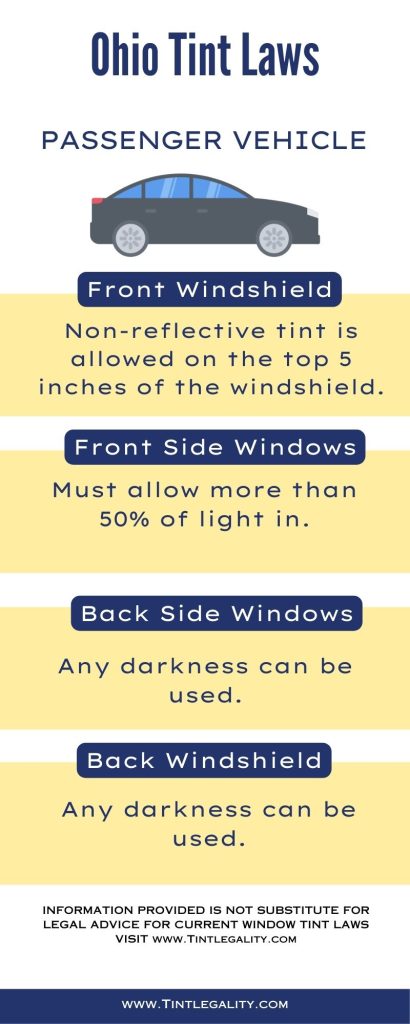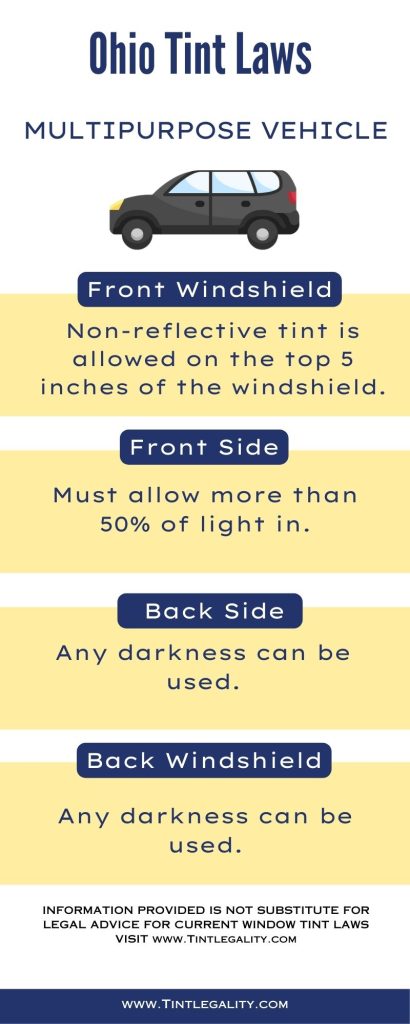Ohio tint laws were enacted in 2004, introducing guidelines on acceptable window tint levels for different vehicle types.
These laws were put in place to ensure road safety, taking into account visibility and glare.
The state of Ohio is serious about its regulations and any contraventions may result in penalties.
Regulations Regarding Window Tint in Ohio
When discussing Ohio tint laws, it’s essential to talk about Visible Light Transmission (VLT).
This percentage indicates how much light a window tint film allows to pass through.
In Ohio, the VLT requirements vary depending on the type of vehicle.
Windshield
For windshields, the regulations permit a non-reflective tint along the top five inches.
This regulation applies to all vehicles, whether it’s a sedan or an SUV.
The aim is to prevent any impairment of the driver’s visibility.
Front Side Windows
Moving to the front side windows, Ohio tint laws mandate that these must allow more than 50% of light to pass through.
This high level of visibility ensures the driver has a clear view of side mirrors and other vehicles on the road.
Back Side Windows
For the back side windows, the laws are slightly more lenient.
There are no specific VLT requirements for these windows, which means you can apply a darker tint if you wish.
Rear Window
Similar to the back side windows, the rear window also does not have a specified VLT under Ohio tint laws.
However, your vehicle must be equipped with both left and right-side rearview mirrors if the rear window is tinted.


Additional Regulations
Beyond the VLT requirements, there are additional regulations you should be aware of.
For example, Ohio law does not allow the use of any color of tint that is metallic or mirrored in appearance.
Reflection
Reflective materials are not permitted on any windows according to Ohio window tint laws.
This regulation helps reduce the risk of glare for other drivers.
Medical Exemptions
Unlike some other states, Ohio does not offer medical exemptions for window tinting.
Color Restrictions
In terms of color restrictions, Ohio is straightforward. No colors are explicitly banned for use in window tints.
Side Mirrors
Side mirrors are not restricted under Ohio tint laws, however, if a rear window is tinted, the vehicle must have dual side mirrors.
Exceptions to Legal Limits
At present, Ohio does not specify any exceptions to these legal limits on window tinting.
Penalties for Breaking the Law
Now let’s turn to the repercussions of breaking these laws.
Fines
The penalties for non-compliance with Ohio tint laws are typically monetary. The fines escalate with repeated offenses, as follows:
- First Conviction: Typically, a first-time offender can expect to pay around $120.
- Second Conviction: The fine for a second offense can be higher, depending on the specific circumstances and the discretion of the court.
- Third Conviction: With a third offense, fines can escalate significantly, and additional penalties may apply.
Other Penalties
Apart from fines, there may be other penalties for non-compliance with Ohio tint laws. It’s important to consult with legal counsel or your local DMV for specifics.
In conclusion, Ohio’s tint laws were enacted to ensure safety on the roads.
With clear guidelines on window tint levels and penalties for non-compliance, every vehicle owner needs to stay within the legal limits.
Faq’s
Is 35% tint illegal in Ohio?
No, 35% tint is not illegal for rear windows in Ohio.
How much is a ticket for dark tint in Ohio?
The fine for dark tint typically start around $120.
Can I have a 5% tint in Ohio?
Yes, 5% tint is allowed on rear windows in Ohio.
What is the lowest tint in Ohio?
The lowest tint allowed on front side windows is 50%.
References: